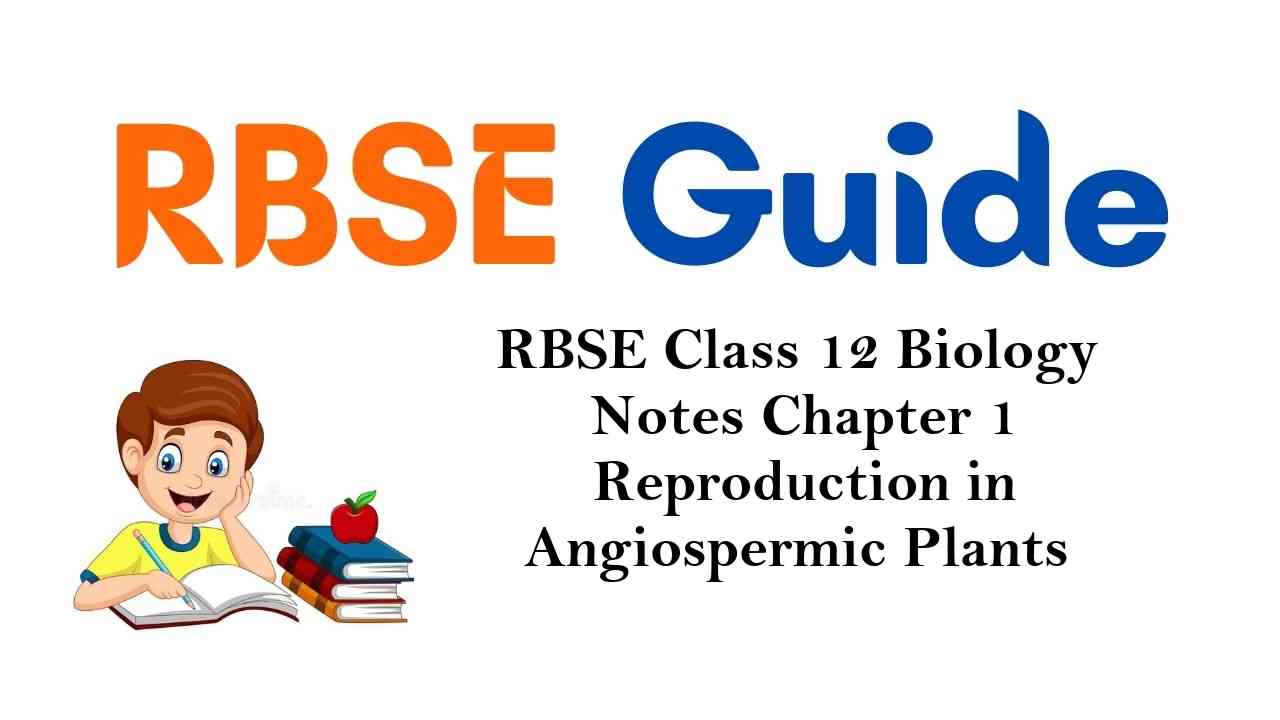Rajasthan Board RBSE Class 12 Biology Notes Chapter 1 Reproduction in Angiospermic Plants
Life in all organisms involves birth, growth, maturity, reporduction and death. In angiospermic plants the life begins with the germination of seeds and ends with the formation of seeds. Reproduction is necessary to multiply in number and continuation of the species from one generation to another. The plant body in angiosperms is a dipoloid sporophyte differentiated in to root stem and leaves. There are two basic methods of reproduction in these plants.—
Sexual and asexual.
The two essential events of sexual reproduction are
- meiosis-by which the diploid sporophyte forms haploid gametes and
- fertilization where the male and female gametes fuse to form a diploid zygote and thus restores the diploid sporophytic phase.
A sexual Reproduction
The methods of reproduction which do not involve meiosis and fertilization are known as asexual reproduction or apomixis. During asexual reproduction only mitotic divisions take place and hence the progeny formed is genetically similar to the parent plant.
Types of Asexual Reproduction
Asexual reproduction is of following types
- Agamospermy—In this method, the seed is formed but without the act of fertilization.
- Vegetative propagation or Vegetative reproduction— These are the methods in which the vegetative part of the plant body such as stem, root, leaf etc. are used in multiplication of plant.
![]()
Agamospermy
(A = without, gamous = union of gametes, sperm = seed). It is a form of reproduction in which seeds are formed without involving fusion of gametes. In agamospermy the reproductive unit is the seed but the embryo present in the seed is not formed from a diploid zygote but is formed from a diploid egg formed from megaspore mother cell directly (wihtout meiosis) or from the cells of nucellus. Further details of agamospermy are dealt in chapter 20.
Vegetative Propagation or Vegetative Reproduction
Vegetative reproduction can be defined as formation of new individuals from any vegetative part of plant body. In this method of reproduction, a portion of the vegetative part of plant is separated or gets detached from mother plant and develops in to a new and indepdenent plant.
Several plant species produce modified structures specially for their multiplication and perpetuation in nature. At the same time man has developed several methods for multiplication of economically useful plants by artificial vegetative propagation. Thus vegetative reproduction of plants can be described under two separate headings
Natural vegetative Propagation
Different plant parts become modified to take the function of vegetative propagation. Some of these are as follows :
1. Vegetative propagation by stems :
(a) Tuber: It is a modified undergound stem developed from stem tip. The “eyes” or buds present in the tuber grow in to a newr plant under favourable conditions. “The potato (Solatium tuberosum) tuber is the most commonly used tuber.
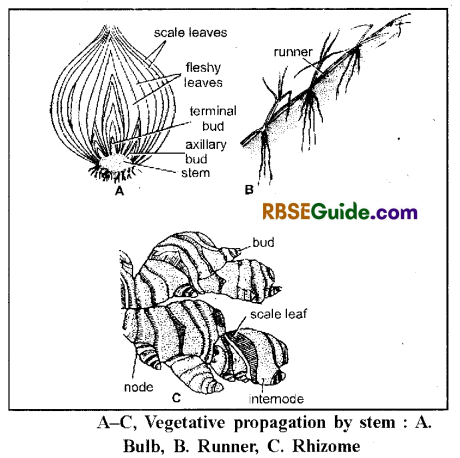
(b) Rhizome : “The underground horizontally growing stem is rhizome. These have distinct nodes and intemodes and axillary buds. Axillary buds grow to form aerial shoot which later separate to form new plant. The common example includes ginger (Zingiber).
![]()
(c) Corm : It is a condensed form of rhizome which grows in vertical direction. The axillary buds grow in to new plants. The common example is taro (Colocasia).
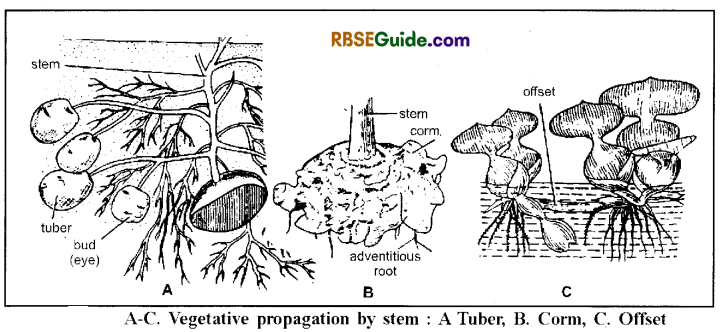
(d) Bulb : It has a very’ short and condensed stem and apical and axillary buds. Some of these grow’ to form aerial shoot; e.g. onion (Allium).
(e) Runners : These are subaerial creeping stems which produce adventitive roots at nodes. These break up at places and each piece grows as an independent plant e.g. doob grass
(Cynodon).
(f) Offset : It is similar to runner in being prostsate and has more or less thickened branch with a tuft of leaves at the apex, the common example is water hyacinth (Eichhornia) and water lettuce (Pistia).
![]()
2. Vegetative propagation by roots : In a few cases roots also become modified and help in vegetative propagation. Some common examples are sweet potato (Ipomoea batatas), Asparagus and Dahlia.
3. Vegetative propagation by leaves : Generally leaves do not help in vegetative propagation. However in Bryophyllum pinnatum, buds develop along the leaf margins. These buds grow’ in to plantlets which on detachment establish as independent plants.
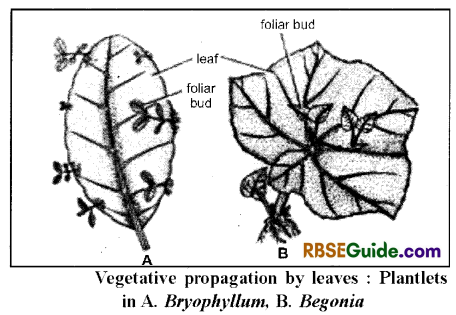
4. vegetative propagation by reproductive parts : In some plants special mutlicellular structures, called bulbils develop on inflorescence. These are transformed floral buds. When these are shed from the plant, they develop in to new plants e.g. onion (Allium cepa) and American aloe (Agave).
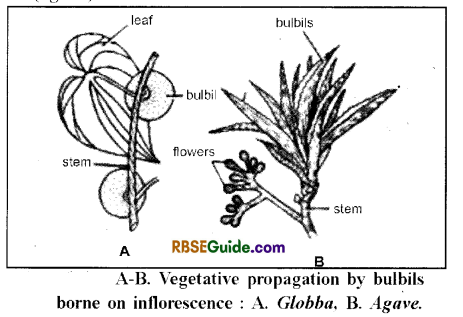
Artificial vegetative propagation
These methods are devised by human and used for propagation of economically important plants. Various parts developed by plants for their natural vegetative propagation have also been practiced for artificial vegetative propagation. This is commercially useful because the new individuals produced by this method maintain the desirable
characters of the parent. A population of genetically identical plants obtained from an individual by vegetative propagation is called a clone. Artificial methods of vegetative propagation include cuttings, layering, grafting and micropropagation.
1. Cuttings :
(a) Stem-cuttings : Many plants such as rose, sugarcane, garden croton, china rose, Duranta, Coleus, Bougainvillea etc. may be easily multiplied by stem cuttings. When cuttings from such plants are put in to soil, they strike roots at the base and develop buds. Some times roots are not easily produced in the cuttings, then these are treated with IAA which promotes rooting.
(b) Root cuttings : Sometimes root cuttings put in moist soil sprout forming roots and shoots as in lemon, tamarind etc.
![]()
2. Layering : In this method, roots are induced in the stem while it is still attached to the parent plant. Later on this part is detached and grown as an independent plant. There are two common types of layering.
(a) Mound layering : In this case, a branch near ground is bent down, a ring of bark (2.5-5.0 cm) is removed and this portion is pushed in the soft moist soil. It is done in such a way that the tip of the branch remains above ground. In a few days or weeks the coverd part of stem strikes adventitious roots. At this stage the branch is cutt oft’ from the parent plant and gr.own separately. Common examples are jasmine, grape¬-wine, lemon, rose etc.
(b) Air layering or Gootee : This technique is employed in trees with thick branches and which can not be bent easily. During early rains, a healthy and woody branch is selected and is girdled (i.e. a ring of bark, 2.5-5 cm long is sliced oft). The girdled part is covered with moist moss or cotton and then covered with polythene bag or jute piece. This covered part is known as Gootee. To keep the gootee wet, an earthen pot with a minute hole at the bottom may be hang over the gootee as shown in the diagram. Roots develop, usually, within 1-3 months. It is then separated from the parent plant and planted in the soil.
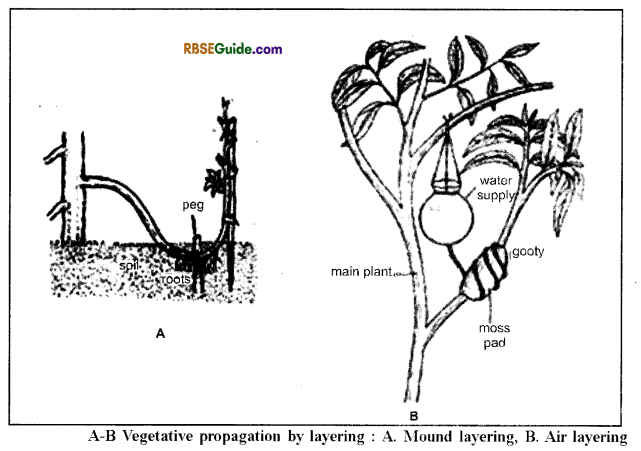
3. Grafting : This is a commonly practised method ¡n horticulture. In this method two different plants are joined to develop a new variety. In this process small branch of a plant is inserted into a rooted plant of the same or allied species so as to establish an organic union between the two. The branch which is inserted is known as the Scion or graft, and the plant in which the branch is inserted and which is rooted to the soil is known as the stock. The scion grows, retaining all its qualities, while the stock which may be of inferior quality, supports the scion by supplying water and food material. This method is useful in commercial plants such as rose, mango, apple, pear, guava, Citrus etc. Main methods of grafting are as follows:
![]()
(a) Whip or Tongue grafting : In this method both scion and stock are of similar thickness. 5-8 cm long cut is made in both scion and stock as shown in the diagram.
After that a V-shaped incision is made in the stock and a complimentary incision is made in scion. The two are tightly fixed and covered with grafting wax.
(b) Wedge grafting : This method is adopted when diameter of both scion and stock is exactly same. The V shaped incsion is made in the stock where as wedge shaped incision is made in the scion. The two are then joined together, tightly fixed and sealed with grafting
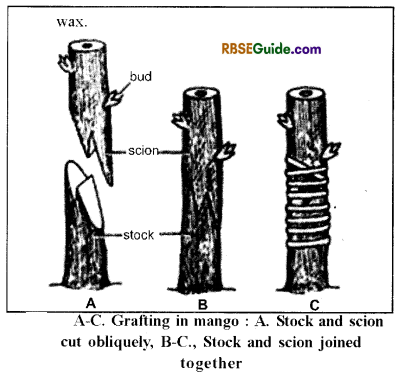
(c) Crown grafting: This method is applied in case where diameter or thickness of stock is many limes more than scion. The bark of the stock is cut through from the surface downwards to a length of 12 to 15 cm. A small branch of same species is incised and this is inserted into the slit in the bark and tied firmly. The wound is covered with grafting wax.
(d) Bud grafting : In this method, a T-shaped incision is made in the bark of the stock and a bud from a selected plant is inserted into the T-shaped slit and bandaged properly. By this method it is possible to gl ow several vari eties of rose on one stock.
4. Micropropagation : This is a modern technique, used for raising disease free plants, homozygous diploids etc. We will learn in details about this in chapter 20.
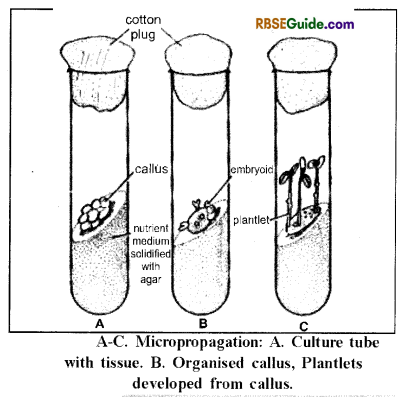
Sexual Reproduction
In angiosperms sexual reproduction takes place in In angiosperms sexual reproduction takes place in the flower. Flower is a modified shoot with limited growth. The stalk of flower is called pedicel. I’he tenninal broader part of pedicel is called thalamus. In a typical Ilower. four types of appan(lagcs are arranged on tite thalamus in
whorls. These are :
(i) Calvx
(ii) Corolla
(iii) Androecium
(iv) Goecium.
(i) Calyx : It is the outer most whorl of tite flower. Individual unit of calyx is called sepal. These arc green coloured leafy structures.
(ii) Corolla : It is the second whorl and made up of petals.These are differently coloured, The calyx and corolla help onl’v in the process of sexual reproduction but do not take part in this process. hence these are reffered as accessory whorls.
![]()
(iii) Androecium : It is male reproductive whorl and consists of stamens. Each stamen represents a modified sporophyll.
(iv) Gynoecium : The inner most whorl is the female reproductive whorl. Individual unit of gynoecium is called carpel. A carpel also represents a modified sporophyll. Androecium and gynoecium are reffered as essential or necessary whorls as these two whorls participate in the act of sexual reproduction.
